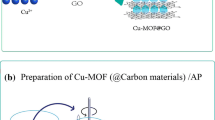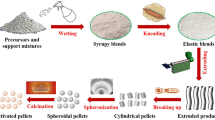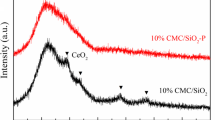Abstract
Non-thermal plasma (NTP) co-catalytic technology is a waste gas treatment technology with high energy efficiency and little by-product. Catalyst plays an important role in the process of NTP co-catalytic degradation of contaminants. However, the performance of the catalyst is not only directly related to active center but also closely related to carrier. In this study, we successfully prepared stable Cu-doped catalysts with bicontinuous structure, using Cu(NO3)2, Al(NO3)3, and tetramethoxysilane as precursors through sol–gel process accompanied by phase separation. Scanning electron microscopy (SEM), energy dispersion X-ray spectroscopy (EDS), X-ray photoelectron spectroscopy (XPS), temperature programmed desorption (TPD), Brunauer–Emmett–Teller method (BET), and mercury intrusion porosity (MIP) were used to investigate the structure, properties, and the role of Al. It was found that in this Cu-doped system, addition of Al can produce Brønsted acidic sites and facilitate the divalent Cu dope into neutral Si skeleton to form stable complexes. Then, it was used as catalyst in NTP system to study the performance of the system and degradation mechanism of H2S. When binary metal catalyst was used, synergistic NTP system creates a secondary electron emission to enhance the field strength, 20 mg·m−3 H2S has the best degradation efficiency, and Cu-doped catalysts can cyclic utilization. At the same time, selective oxidation occurs in the system; elemental sulfur is produced.













Similar content being viewed by others
Data Availability
The datasets generated during and/or analyzed during the current study are available from the corresponding author on reasonable request. All data generated or analyzed during this study are included in this published article [and its supplementary information files].
References
Allen, M. R., Braithwaite, A., & Hills, C. C. (1997). Trace organic compounds in landfill gas at seven U.K. waste disposal sites. Environmental Science & Technology, 31(4), 1054–1061. https://doi.org/10.1021/es9605634
Chan, Y. H., Lock, S. S. M., & Wong, M. K. (2022). A state-of-the-art review on capture and separation of hazardous hydrogen sulfide (H2S): Recent advances, challenges and outlook*. Environmental Pollution, 314, 120219. https://doi.org/10.1016/j.envpol.2022.120219
Chang, Z., Wang, C., & Zhang, G. (2020). Progress in degradation of volatile organic compounds based on low-temperature plasma technology. Plasma Processes and Polymers, 17(4), e1900131. https://doi.org/10.1002/ppap.201900131
Chen, J., Wang, Y., & Shao, L. (2022). In-situ removal of odorous NH3 and H2S by loess modified with biologically stabilized leachate. Journal of Environmental Management, 323, 116248. https://doi.org/10.1016/j.jenvman.2022.116248
Chen, L., Falsig, H., & Janssens, T. V. W. (2018). Activation of oxygen on (NH3-Cu-NH3) (+) in NH3-SCR over Cu-CHA. Journal of Catalysis, 358, 179–186. https://doi.org/10.1016/j.jcat.2017.12.009
Chen, L., Janssens, T. V. W., & Skoglundh, M. (2019). Interpretation of NH3-TPD profiles from Cu-CHA using first-principles calculations. Topics in Catalysis, 62(1–4), 93–99. https://doi.org/10.1007/s11244-018-1095-y
Chen, S., Li, J., & Zhang, Y. (2014). Production of lower olefins with highly dispersed Ru catalysts supported on Al-SBA-15 in Fischer-Tropsch synthesis. Topics in Catalysis, 57(6–9), 437–444. https://doi.org/10.1007/s11244-013-0199-7
Curren, J., Hallis, S. A., & Snyder, C. C. L. (2016). Identification and quantification of nuisance odors at a trash transfer station. Waste Management, 58, 52–61. https://doi.org/10.1016/j.wasman.2016.09.021
Dang, X., Huang, J., & Kang, L. (2012). Research on decomposition of hydrogen sulfide using non-thermal plasma with metal oxide catalysis. In G. Yang (Ed.), 2012 International Conference on Future Energy, Environment, and Materials, Pt B (Vol. 16, pp. 856–862). Amsterdam: Elsevier Science Bv. https://doi.org/10.1016/j.egypro.2012.01.137.
Dong, J., Chen, X., & Ji, F. (2021). Copper-mediated simple and direct aerobic oxidative esterification of arylacetonitriles with alcohols/phenols. Applied Organometallic Chemistry, 35(1), e6073. https://doi.org/10.1002/aoc.6073
Guo, X., Li, W., & Nakanishi, K. (2013a). Preparation of mullite monoliths with well-defined macropores and mesostructured skeletons via the sol-gel process accompanied by phase separation. Journal of the European Ceramic Society, 33(10), 1967–1974. https://doi.org/10.1016/j.jeurceramsoc.2013.02.018
Guo, Y.-F., Ye, D.-Q., & Chen, K.-F. (2007). Toluene removal by a DBD-type plasma combined with metal oxides catalysts supported by nickel foam. Catalysis Today, 126(3–4), 328–337. https://doi.org/10.1016/j.cattod.2007.06.025
Jiang, J., Wang, F., & Wang, J. (2021). Ammonia and hydrogen sulphide odour emissions from different areas of a landfill in Hangzhou, China. Waste Management & Research, 39(2), 360–367. https://doi.org/10.1177/0734242X20960225
Joseph, H. M., & Sugunan, S. (2021). Copper loaded HPfCNT/TiO2 ternary nanohybrids as green and robust catalysts for dehydrogenation of cyclohexanol under visible light. Materials Science in Semiconductor Processing, 129, 105784. https://doi.org/10.1016/j.mssp.2021.105784
Kim, H.-H., Teramoto, Y., & Negishi, N. (2015). A multidisciplinary approach to understand the interactions of nonthermal plasma and catalyst: A review. Catalysis Today, 256, 13–22. https://doi.org/10.1016/j.cattod.2015.04.009
Konishi, J., Fujita, K., & Nakanishi, K. (2006). Monolithic TiO2 with controlled multiscale porosity via a template-free sol-gel process accompanied by phase separation. Chemistry of Materials, 18(25), 6069–6074. https://doi.org/10.1021/cm0617485
Kosslick, H., Lischke, G., & Parlitz, B. (1999). Acidity and active sites of Al-MCM-41. Applied Catalysis A: General, 184(1), 49–60. https://doi.org/10.1016/S0926-860X(99)00078-2
Li, S., Yu, X., & Dang, X. (2021). Non-thermal plasma coupled with MOx/gamma-Al2O3 (M: Fe Co, Mn, Ce) for chlorobenzene degradation: Analysis of byproducts and the reaction mechanism. Journal of Environmental Chemical Engineering, 9(6), 106562. https://doi.org/10.1016/j.jece.2021.106562
Liu, S. H., Zhao, X. W., & Pan, T. S. (2012). Template effect of hydrolysis of the catalyst precursor on growth of carbon nanotube arrays. Journal of Colloid and Interface Science, 374, 34–39. https://doi.org/10.1016/j.jcis.2012.02.005
Ma, X. M., Zhang, M. X., & Min, F. F. (2015). A study of organic sulfur analysis in coal using non-destructive techniques. Energy Sources Part a-Recovery Utilization and Environmental Effects, 37(24), 2716–2723. https://doi.org/10.1080/15567036.2012.736916
Maie, N., Anzai, S., & Tokai, K. (2022). Using oxygen/ozone nanobubbles for in situ oxidation of dissolved hydrogen sulfide at a residential tunnel-construction site. Journal of Environmental Management, 302, 114068. https://doi.org/10.1016/j.jenvman.2021.114068
Monolithic Silicas in Separation Science. (2011). Focus on Catalysts, 2011(5), 8. https://doi.org/10.1016/S1351-4180(11)70200-8.
Na, K., Park, W., & Seo, Y. (2011). Disordered assembly of MFI zeolite nanosheets with a large volume of intersheet mesopores. Chemistry of Materials, 23(5), 1273–1279. https://doi.org/10.1021/cm103245m
Nakanishi, K. (2008). Hierarchically porous oxides, hybrids and polymers via sol-gel accompanied by phase separation. In C. Barbe, R. M. Laine, C. Sanchez, & U. Schubert (Eds.), Organic/Inorganic Hybrid Materials - 2007 (Vol. 1007, pp. 51–62). Warrendale: Materials Research Soc. https://www.webofscience.com/wos/alldb/summary/3cd89fb0-244b-4d77-9e97-66adb9379966-6a2a4e47/relevance/1. Accessed 12 Jan 2023.
Nakanishi, K., & Soga, N. (1991). Phase separation in gelling silica-organic polymer solution: Systems containing poly (sodium styrenesulfonate). Journal of the American Ceramic Society, 74(10), 2518–2530. https://doi.org/10.1111/j.1151-2916.1991.tb06794.x
Roland, U., Holzer, F., & Kopinke, E. D. (2005). Combination of non-thermal plasma and heterogeneous catalysis for oxidation of volatile organic compounds Part 2. Ozone decomposition and deactivation of gamma-Al2O3. Applied Catalysis B-Environmental, 58(3–4), 217–226. https://doi.org/10.1016/j.apcatb.2004.11.024
Scaglia, B., Orzi, V., & Artola, A. (2011). Odours and volatile organic compounds emitted from municipal solid waste at different stage of decomposition and relationship with biological stability. Bioresource Technology, 102(7), 4638–4645. https://doi.org/10.1016/j.biortech.2011.01.016
Shen, S., Wu, B., & Xu, H. (2020). Assessment of landfill odorous gas effect on surrounding environment. Advances in Civil Engineering, 2020, 8875393. https://doi.org/10.1155/2020/8875393
Guo, X. Z., Li, W. Y., & Zhu, Y. (2013b). Macroporous SiO2 monoliths prepared via sol-gel process accompanied by phase separation. Acta Physico-Chimica Sinica, 29(3), 646–652. https://doi.org/10.3866/PKU.WHXB201212252
Xu, S., Zhu, H., & Cao, W. (2018). Cu-Al2O3-g-C3N4 and Cu-Al2O3-C-dots with dual-reaction centres for simultaneous enhancement of Fenton-like catalytic activity and selective H2O2 conversion to hydroxyl radicals. Applied Catalysis B-Environmental, 234, 223–233. https://doi.org/10.1016/j.apcatb.2018.04.029
Yang, H., Dang, Y., & Cui, X. (2023). Selective synthesis of olefins via CO2 hydrogenation over transition-metal-doped iron-based catalysts. Applied Catalysis B-Environmental, 321, 122050. https://doi.org/10.1016/j.apcatb.2022.122050
Funding
This work was supported by Liaoning Provincial Education Department Scientific Research Funding Project (LQGD2020014) and (20201362101).
Author information
Authors and Affiliations
Corresponding authors
Ethics declarations
Competing Interests
The authors declare no competing interests.
Additional information
Publisher's Note
Springer Nature remains neutral with regard to jurisdictional claims in published maps and institutional affiliations.
Supplementary Information
Below is the link to the electronic supplementary material.
Rights and permissions
Springer Nature or its licensor (e.g. a society or other partner) holds exclusive rights to this article under a publishing agreement with the author(s) or other rightsholder(s); author self-archiving of the accepted manuscript version of this article is solely governed by the terms of such publishing agreement and applicable law.
About this article
Cite this article
Chen, S.n., Gao, Y.j., Ming, H. et al. Preparation of Cu-Doped Bicontinuous Catalyst and the Performance in Non-thermal Plasma Co-catalytic Degradation of H2S. Water Air Soil Pollut 234, 469 (2023). https://doi.org/10.1007/s11270-023-06433-2
Received:
Accepted:
Published:
DOI: https://doi.org/10.1007/s11270-023-06433-2




